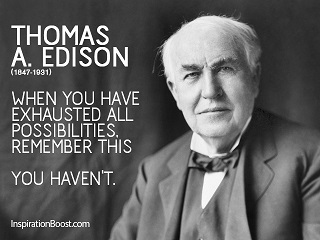Saluting Edison on His Big Day (Or At Least One of Them)

This success came at the end of an enormous number of experiments whose results were disappointing. When someone suggested that Edison was a failure, he replied, “Oh, I’m not a failure; I know 10,000 things that don’t work.” That has to sit close to the top of the most inspirational things ever to usher from the lips of a would-be entrepreneur.
After his ultimate success, he announced: “We will make electricity so cheap that only the rich will burn candles.” Here, 136 years later, we’re still having the same conversation, though now it’s arguably more interesting than it ever has been before, as it includes these imponderables:
• Will our civilization ever include the social costs of burning fossil fuels into the price of electricity? What would be the price per kWh if it included climate change mitigation and medical treatment for the lung disease it’s causing? (Answer: that depends on the exact circumstances, but it would quadruple in certain cases.)
• Similarly, how can we “price in” the value of bringing electricity to those in developing countries who are currently denied access to it? Among the many benefits here is better education, reduction of poverty, and the facilitation of stronger, smaller, healthier families.
• When will “advanced nuclear” be ready for commercialization, a phenomenon that could truly make electricity too cheap to meter?
Our adoration of Edison is well-placed; his accomplishments serve as an eternal beacon of the power of American ingenuity.

I think Tesla heartily deserves mention as well. 🙂
Yes. I’ll write something nice on his birthday….
Ironically Edison also brought forth what may still be the best battery for renewable energy purposes and it was sold to many thousands of farms that were not connected to the grid so they could have power at their disposal. Power to charge these batteries came from onsite wind turbines.
That’s amazing. Let me write a blog post on this.